I
feel more than slightly nauseus reading this excellent piece of
investigative journalism (real
journalism) that delves into the dark truth behind this dreadful,
concocted case surrounding Sergei and Yulia Skripal.
If
we had been living in the pre-internet age it is unlikely any of this
would have come to light and would, like in all tyrannical regimes,
remained as pure rumour.
REVEALED:
Pentagon’s $70 Million Chemical & Biological Program at Porton
Down in UK
In
January, 21WIRE published the journalist Dilyana Gaytandzhieva’s
previous report detailing the Pentagon’s extensive
overseas biological
and chemical weapons facilities in
eastern Europe and central Asia and the dangers it poses to
surrounding populations. Today we learn that this same threat is much
closer to home…
By
Dilyana Gaytandzhieva
SPECIAL REPORT
The
Pentagon has spent at least $70 million on military experiments
involving tests with deadly viruses and chemical agents at Porton
Down –
the UK military laboratory near the city of Salisbury. The secretive
biological and chemical research facility is located just 13 km from
where on 4th March
former Russian spy Sergei
Skripal and
his daughter Yulia were found slumped on a bench following an alleged
Novichok nerve agent poisoning.
Information
obtained from the US federal contracts registry reveals that the
Pentagon’s Defense Threat Reduction Agency (DTRA) has funded
a number of military projects performed
at the
UK Defence Science and Technology Laboratory (DSTL),
or Porton Down, over the last decade. Among them: experimental
respiratory infection of non-human primates (marmosets) with Anthrax,
Ebola virus, Marburg virus, Venezuelan equine encephalitis virus,
Western equine encephalitis virus, and Eastern equine encephalitis
virus. The US Defense Threat Reduction Agency (DTRA) has also funded
experiments on animals which were exposed to chemical agents such as
Sulfur Mustard and Phosgene gas. Phosgene gas was used as a chemical
weapon during World War I where it was responsible for about 85 % of
the 100,000 deaths caused by chemical weapons.
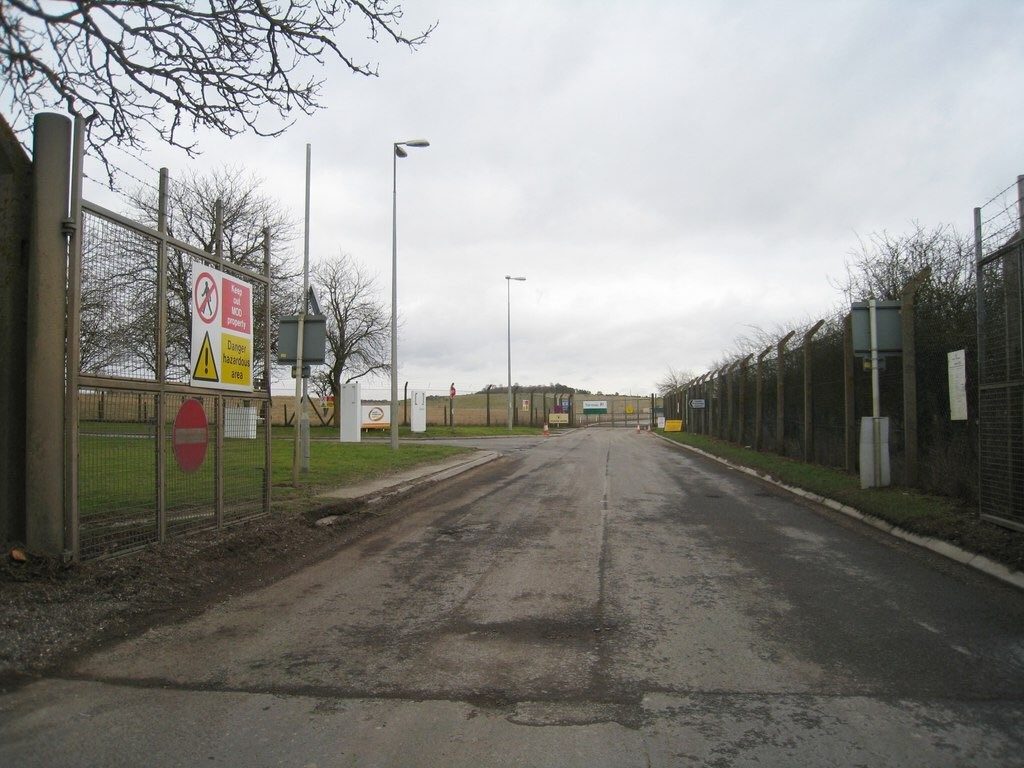
IMAGE: Entrance to Porton Down chemical and biological research facility near Salisbury.
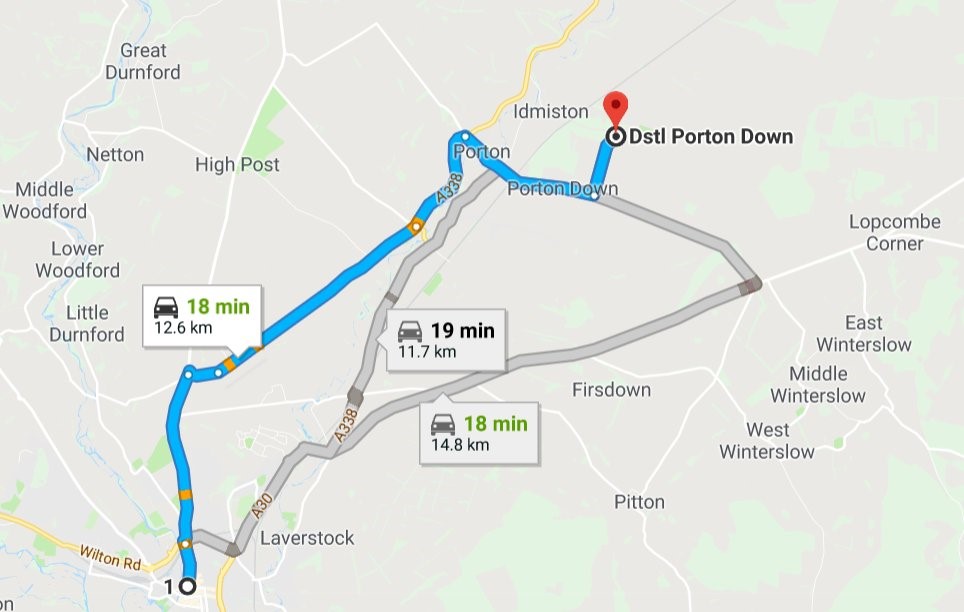
MAP: It may only be a coincidence that Porton Down facility is located only 13 km from the site of the alleged (and still unconfirmed) ‘Novichok’ chemical weapons attack on Sergei Skripal and his daughter Yulia.
DTRA
has also been granted full access to DSTL scientific and technical
capabilities, and test data under a
2011 contract for the collaboration and exchange of
scientific and technical capabilities with the UK Ministry of
Defence.
At
least 122,000 animals used for military chemical and biological
experiments at Porton Down
Animal experiments are
classified as confidential in the UK. Under section 24 of the Animals
(Scientific Procedures) Act 1986, it is a criminal offence to
disclose certain information about animal experiments in the UK.
Data
obtained via the Freedom of Information Act though
gives an idea of the dimensions of military chemical
and biological experiments carried
out at Porton Down. A total of 122,050
animals have
been exposed to deadly pathogens, chemicals and incurable diseases
over the last decade (2005-2016).
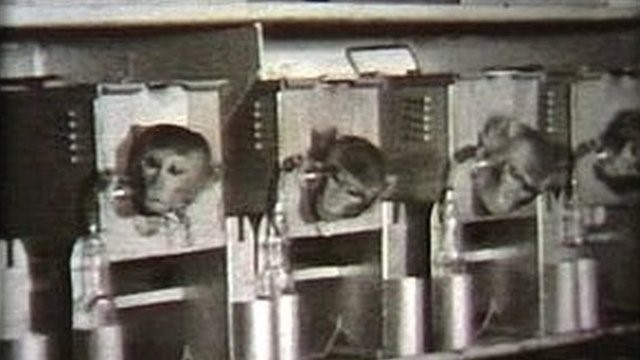
IMAGE: Monkeys being used in warfare agent testing at Porton Down in the past.
Animals
used include mice, guinea pigs, rats, pigs, ferrets, sheep, and
non-human primates. Some of the deadly experiments have been
sponsored by the Pentagon under contracts between DSTL and DTRA.
Scientists at Porton Down have infected, or poisoned, animals in
order to measure time to death and lethal dose of exposure. In
practice, the possible use of the researched virus/chemical gas as a
weapon.
Marmoset monkeys are experimentally infected at Porton Down with Ebola, Anthrax, Marburg Virus and other deadly pathogens. Scientists measure time to death and lethal dose of exposure to the bio agent (Photo Credit: Vic Pigula)
Ebola
as bioweapon
12
Marmoset monkeys were experimentally infected with the Ebola virus,
via aerosol, at Porton Down under a Pentagon-funded project
– Experimental
respiratory infection of marmosets with Ebola virus Kikwit (the
Zaire strain of the Ebola virus which killed more than 245 people in
Zaire, now Democratic Republic of Congo, in 1995). The project was
part of a $6.3 million DTRA program running at Porton Down from 2012
to 2016 – Development
of common marmoset models for category A/B pathogens and product
evaluation in marmosets.
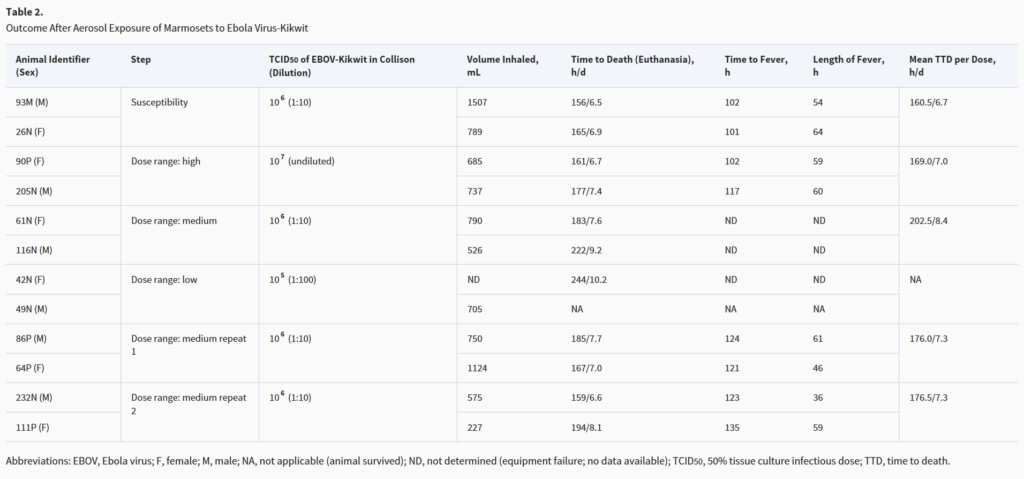
Source: Experimental Respiratory Infection of Marmosets (Callithrix jacchus) With Ebola Virus Kikwit, The Journal of Infectious Diseases, Volume 212, 1 October 2015
The
experiment’s stated goal was to measure the lethal dose of exposure
and time to death meaning that the Ebola virus Kikwit was researched
for its potential as a bioweapon. All infected marmoset monkeys died
from 6 to 10 days after exposure to the Ebola virus.
The
Pentagon also funded studies on the deadly Marburg virus: a $2.6
million project – Experimental
respiratory Marburg virus haemorrhagic fever infection in the common
marmoset,and
another $1.4
million project –
Marburg virus model development, which were undertaken at Porton Down
in 2017. This virus causes viral
hemorrhagic fever and
is listed as a Category
A Bioterrorism Agent.
All infected monkeys died from 8 to 10 days. The aim of the studies
was to examine the dose and time to death for animals exposed to
aerosolized Marburg virus.

Source: Experimental respiratory Marburg virus haemorrhagic fever infection in the common marmoset (Callithrix jacchus), International Journal of Experimental Pathology
Under
another $4.8
million project, funded by DTRA,
Porton Down scientists along with the Pentagon contractor Mapp
Biopharmaceutical tested Susceptibility
and lethality of Western Equine Encephalitis Virus in
mice when infected by the aerosol route. Mapp Biopharmaceutical is an
American pharmaceutical company,
which has developed an Ebola vaccine from the tobacco plant.
According to the study, aerosol infection is the likely route of
exposure to Western Equine Encephalitis Virus in a biowarfare
scenario.
12
Marmoset monkeys were infected with anthrax at Porton Down during an
experiment funded by the US Defense Advanced Research Projects Agency
(DARPA). The study, Experimental
respiratory anthrax infection in the common marmoset (Callithrix
jacchus),
aimed at determining the lethal dose needed to kill 50% of the
animals or the so called LD50 indicator. The value of LD50 for a
substance is the dose required to kill half the members of the tested
population after a specified test duration. Six of the monkeys died
from anthrax from 40 to 140 h.
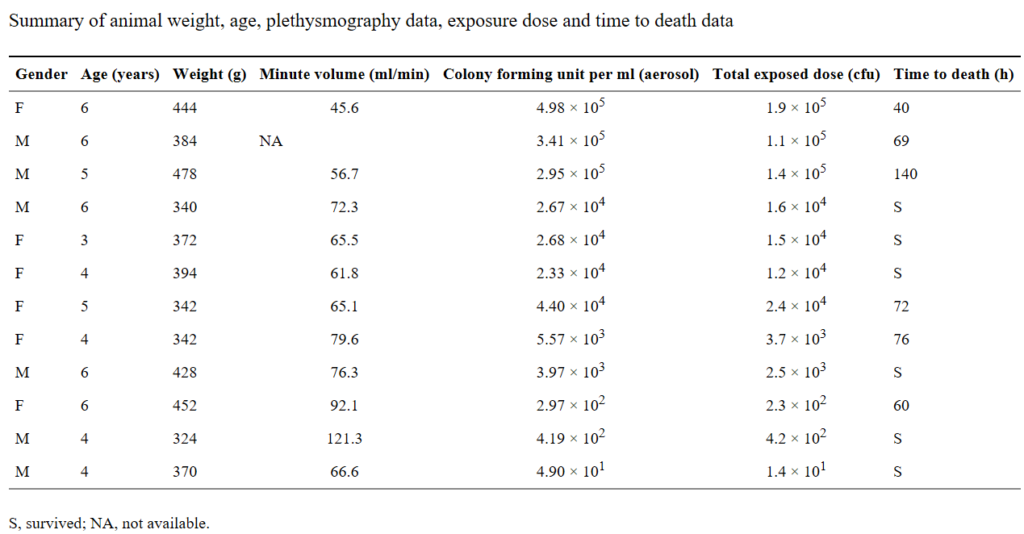
Source: Experimental respiratory anthrax infection in the common marmoset (Callithrix jacchus), US National Library of medicine
Chemical
agent tests
British
military scientists were funded by DTRA to perform Chemical
Agent system testing as
part of a $39.7
million Pentagon program (2012-2017)
at Porton Down. Documents prove that the US Department of Defense
Agency – DTRA funded animal experiments with chemical agents at the
secretive British military lab.
In
2016 Porton Down scientists along with their colleagues from the US
Army Medical Research Institute of Chemical Defense published the
results of a joint study Acute
Gene Expression Profile of Lung Tissue Following Sulfur Mustard
Inhalation Exposure in Large Anesthetized Swine.
According to the funding information, this work was supported by two
contracts with the
Defense Threat Reduction Agency (US
Department of Defense). During the experiment at Porton Down 16 pigs
were exposed to mustard gas for about 10 minutes, at 12 h post
exposure the animals were killed (three of them died during the
experiment due to complications) and a full post-mortem examination
performed in order to determine the lung damage caused by the sulfur
mustard inhalation.
Sulfur
mustard is a chemical warfare agent that was first used on the
battlefield in World War I. It has been classified as a Class 1 human
carcinogen, meaning that it can also cause cancer. Mustard agents
were regulated under the 1993 Chemical
Weapons Convention as
substances with no use other than in chemical
warfare.
The
last use of Sulfur mustard in battle was confirmed in Syria in
2016. According
to the BBC,
Islamic State (ISIS) jihadists used mustard gas against government
forces in Deir-ez-Zor. The same chemical gas was confirmed to have
been used by ISIS against Kurds in Northern Iraq. According
to The Independent,
the Organisation for the Prohibition of Chemical Weapons (OPCW)
confirmed that laboratory tests had come back positive for sulfur
mustard, after around 35 Kurdish troops fell sick on the battlefield
in August 2015.
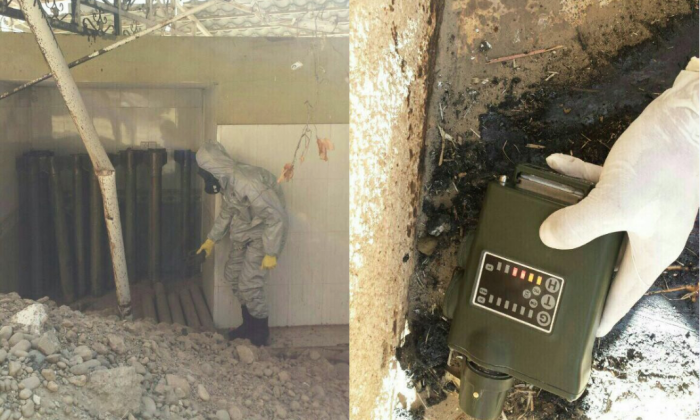
Iraqi soldiers captured a cache of chemical weapons from ISIS in Qayarah, Iraq, the rockets tested positive for sulfur mustard, October 2016. (Source: Ed Alexander/BLACKOPS Cyber)
According
to information obtained from the US Federal contracts registry,
Porton Down scientists 5 months ago completed a $ 2 million military
program involving chemical gas experiments on animals. This program
was funded by the US Department of the Army on behalf of the U.S.
Army Medical Research Institute of Chemical Defense (USAMRICD) and
was launched
in 2008 and
further extended
in 2012.
The work on the program included Phosgene Gas tests. Amongst them
– Continued
Model Development to Establish Reproducible Phosgene Injury at 24
Hours.
According to the program documents, the purpose was to monitor the
development of acute lung injury following phosgene exposure.
Phosgene gas was used extensively as a chemical weapon, most notably
during World War I.
Coincidence:
Guinea pigs at Porton Down and at the home of the poisoned ex-spy
Tests
using nerve agents VX and VM on guinea pigs were
carried out at Poton Down in 2015. The project was funded by the UK
Ministry of Defence.
Interestingly, ginea
pigs were also found at Sergei Skripal’s home in
Salisbury, just a few kilometers away from the secretive chemical and
biological military lab. A photo of the Skripals’ pets – a cat
and guinea pigs, was posted by his daughter Yulia on Facebook.
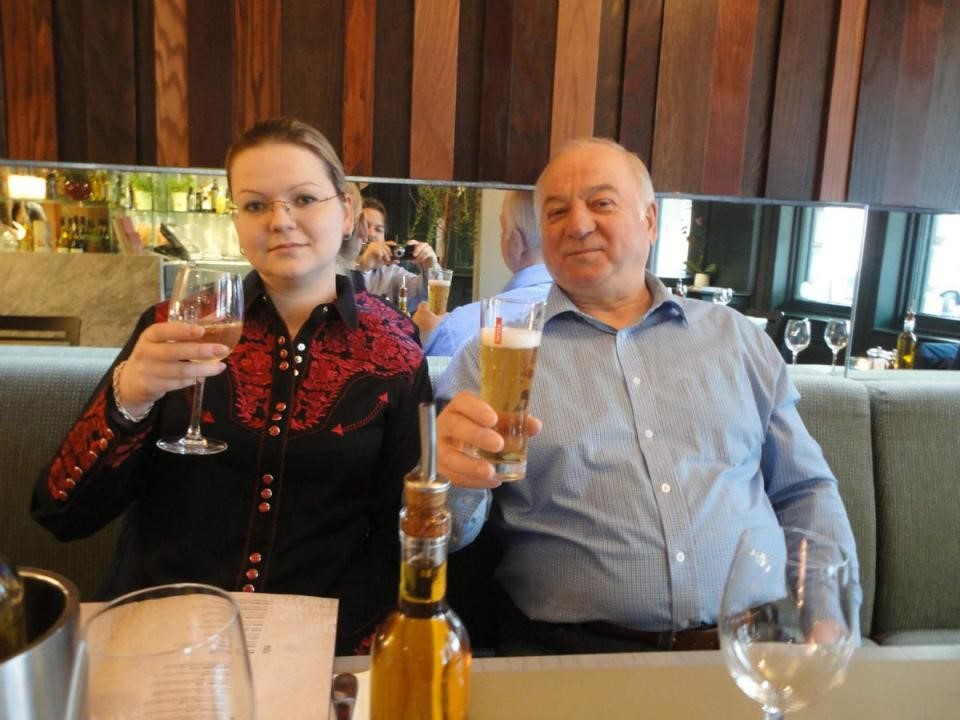
Sergei Skripal and his daughter Yulia (Photo: Facebook)
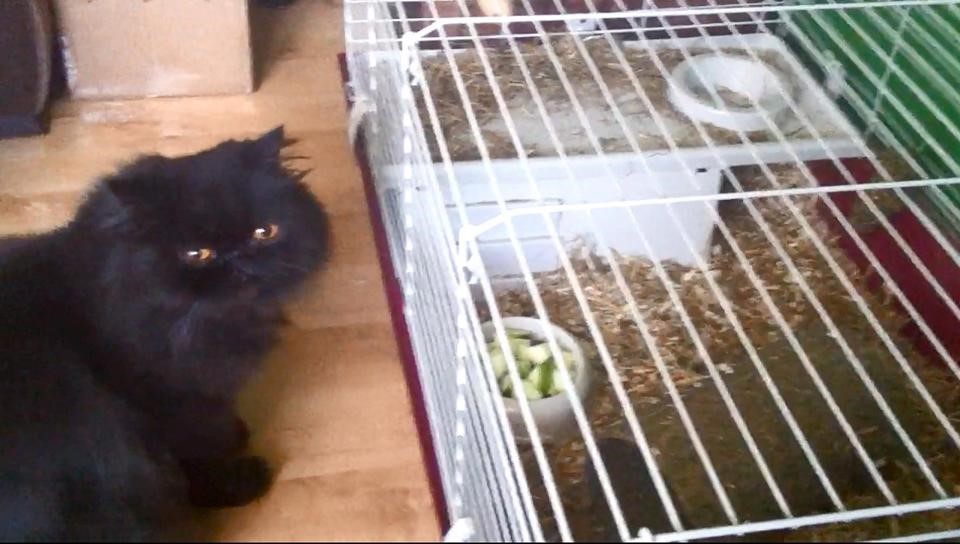
Guinea pigs were found in the house of the poisoned ex-spy in Salisbury, just a few kilometers away from Porton Down, where such guinea pigs were used for nerve agent chemical tests (Photo: Yulia Skripal, Facebook)
In a
2015 report to the UK parliament the
UK Ministry of Defence does confirm the use of animals for military
chemical and biological experiments. The ministry states: “DSTL is
proud to deliver cutting-edge science and technology for the benefit
of national defence and security. Part of its work is to provide safe
and effective countermeasures against the threat posed by chemical
and biological weapons and to enhance the treatment of conventional
casualties on the battlefield, which could not currently be achieved
without the use of animals”.
Porton
Down scientists test chemical gas on London Tube passengers
Chemical gas was released on thousands of unsuspecting commuters during a military experiment on the London Underground, documents reveal. These chemical tests were performed in 2013 by scientist from Porton Down.

TERROR ON THE TUBE? Porton Down scientists released chemical gas on the London Underground in 2013.
The
UK government never informed the British public of the military
experiment on the London Underground. Thousands of people were
exposed to chemical gas without their knowledge. Nor did the Ministry
of Defence ask for their consent to participate in such military
experiments. Information about the project can be obtained from a
2016 US
Department of Homeland Security (DHS) document entitled
Environmental Assessment of Proposed NYC Subway Tracer Particle and
Gas Releases for the Underground Transport Restoration Project.

5 PFTs, SF6 and Urea were released on the London Underground in 2013 in the form of liquid aerosol droplets. Source: US Department of Homeland Security (DHS)
The
document provides information about other programs running in the USA
and UK from 2005 to 2016. Among them are the London Underground
chemical trials. They were conducted by the Defense Science and
Technology Laboratory (DSTL), also known as Porton Down.
Information
obtained from the UK government contracts registry confirms that
Porton Down scientists conducted a study involving access to the
London tube under a
3-year contract with the London Underground (2011-2014).
The content of the project is not specified though.
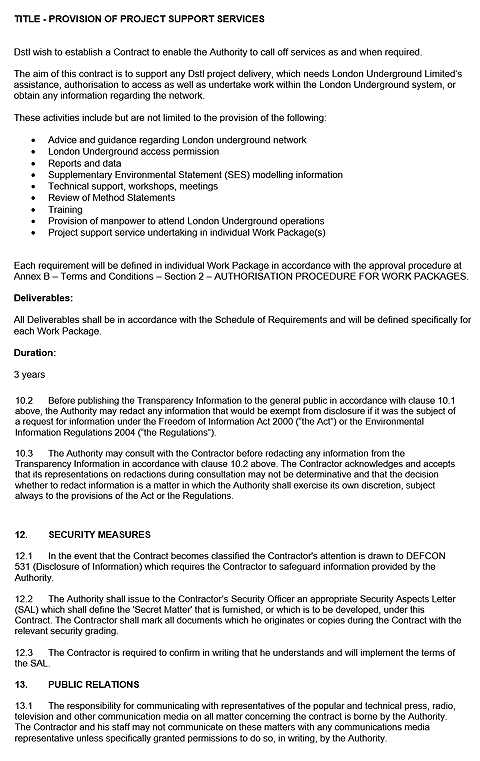
The London Underground is prohibited from public disclosure of information about the Porton Down project without permission, according to the contract documents. Source: data.gov.uk
The
controversial military laboratory was investigated for chemical and
biological experiments on humans in the past. Up to 20,000 people
took part in various trials from 1949 to 1989. In 2008, the UK
Ministry of Defence paid 360 veterans £3 million without admitting
liability.

Ronald
George Maddison (image, left) was a twenty-year-old Royal Air Force
engineer who died while undergoing tests with sarin at Porton Down in
1953, according to declassified military documents.
Even
recently, UK have been actively involved in the development of the
lethal VX gas and have conducted numerous
lives tests.
Similarly, the United States has an extensive and sordid record of
using both chemical and biological weapons at home and overseas.
Aside from civilian deaths, a number of US serviceman deaths during
field testing and other ‘live’ testing. See more evidence of the
US record here and here.

REVEALED: Previously classified US document reveals how US official were well aware of the risks of exposing their own personnel to biological and chemical agents – and yet, this did not stop them from running ‘live’ tests.
Powder
dissemination of chemical or biological agents
Presently
Porton Down scientists produce and test dissemination of biological
and/or chemical agents as they did in the past, documents from the UK
government contracts registry reveal. Although the information is
redacted, it still raises questions as to why the UK military needs
to develop a new technique for dissemination of chemical or
biological agents via the inhalational route. A
private contractor – Red Scientific Ltd, was awarded a £50,000
contract in
2012 “to explore techniques that could be used to manipulate the
flow ability of dry powders, principally to understand the delivery
of solid particulate by inhalation, and to apply a variety of
innovative powder manipulation techniques to a specific irritant
powder (provided by DSTL)”. If the work in 2012/13 proves to be
successful there is potential for a second phase to be pursued in
2013/14 examining other powder materials with the same techniques,
the contract documents reveal. The project’s stated goal is marked
improvement in the efficiency of aerosolisation over current
techniques used at DSTL.
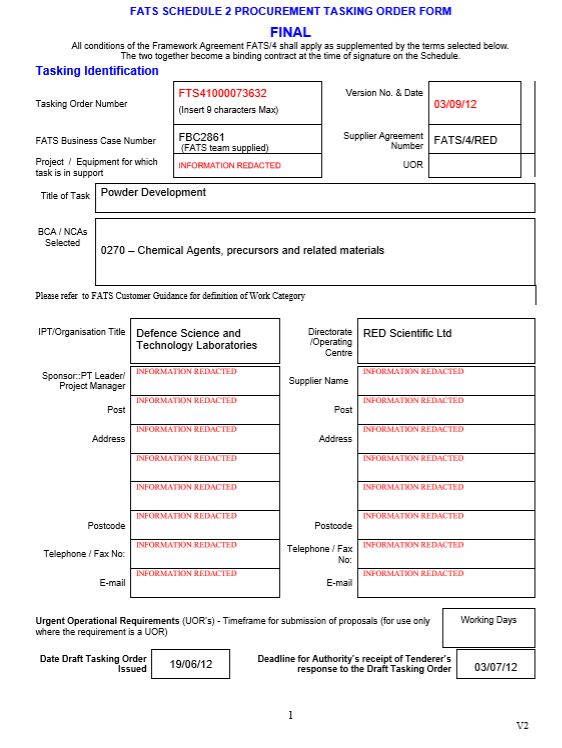
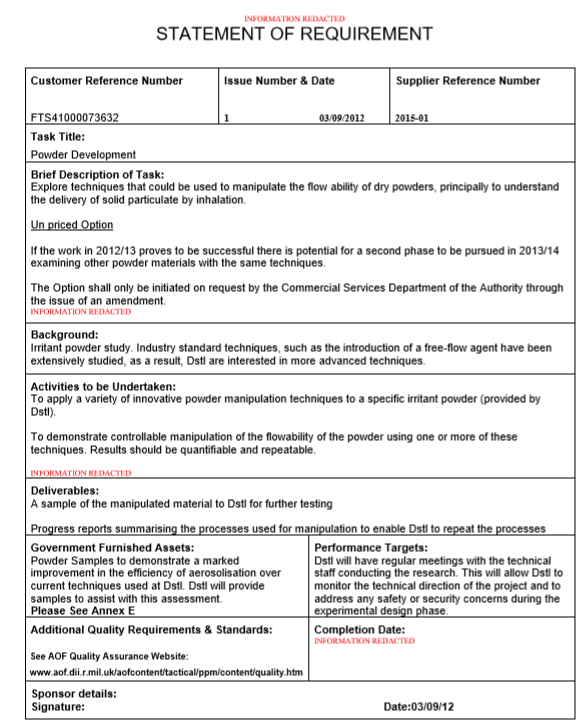
DSTL has awarded a private contractor to explore more advanced techniques for powder dissemination of chemical/biological agents. Source: data.gov.uk
DSTL
has also tested dissemination techniques in wind tunnels. A private
company – NIAB
Trading Ltd, was awarded a £12,020 contract to
provide facilities and expertise to assist with wind tunnel
assessments.
Such
experiments involving the release of bacteria were conducted in the
UK in the past during the joint UK-US military operation DICE. A
declassified US Army document reveals
that a series of 24 field trials took place off the coast of Portland
and in Lyme Bay in the UK in 1975. Each field trial involved the
spraying of massive bacterial aerosols from a converted Land Rover.
Although the US and UK joined the UN Conventions on the prohibition
of chemical and biological weapons, documents prove that their
military programs have never ended.
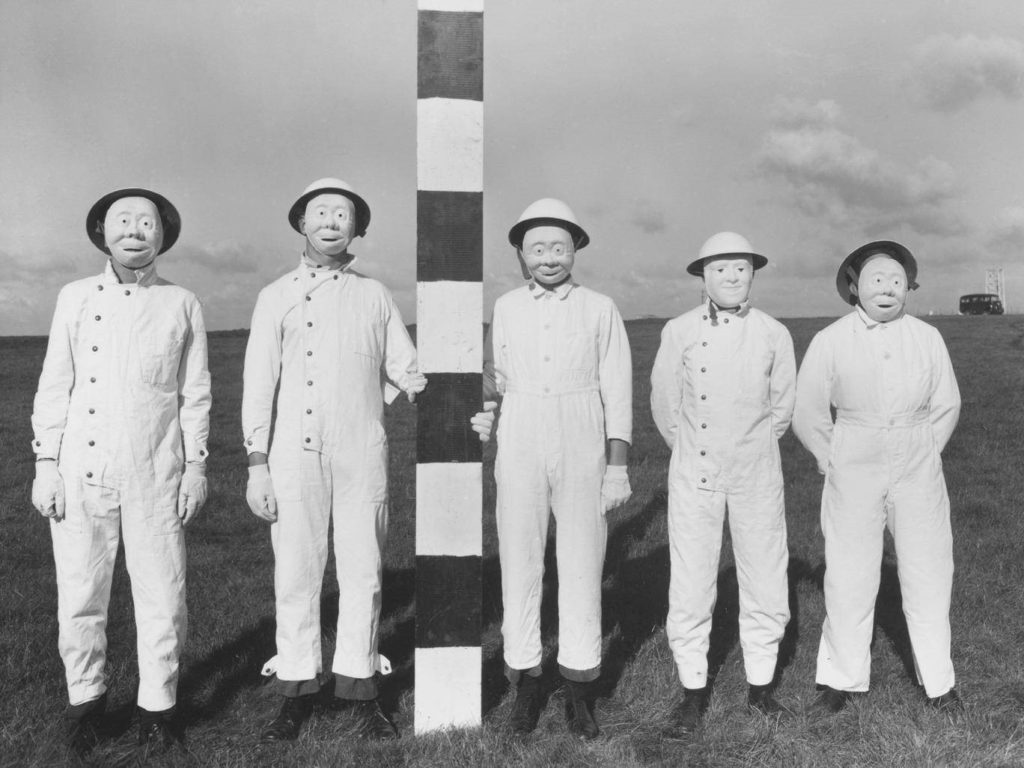
Porton Down scientists conducted field tests in 1956. The masks on their faces allowed the collection of warfare simulants which had been sprayed from aircraft (Photo Credit: Imperial War Museum)
US
official lied in Brussels about the Pentagon biolaboratories
Robert Kadlec, Assistant
Secretary at the US Department of Health, categorically denied the
existence of an American bio-weapons program at a seminar on the
threat of biological and chemical weapons. The event was organized by
the European Parliament on 7th March in Brussels.
Asked why the information about the US military bio-laboratories in
25 countries bordering on Russia, China and Iran (the Pentagon’s
main rivals) is classified, Kadlec responded: “They are not
classified, they are openly available to anyone who wants to look at
them.”
Full
video of my challenge to US official Robert Kadlec’s at the
European Parliament in Brussels:
Documents about the
Pentagon offshore bio-laboratories prove him wrong though…

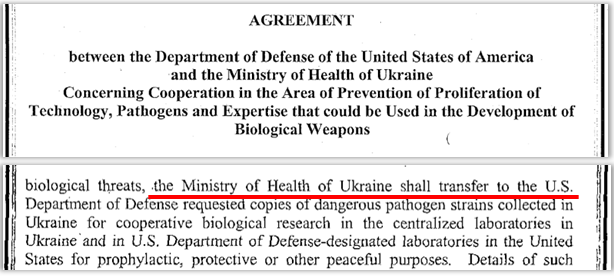
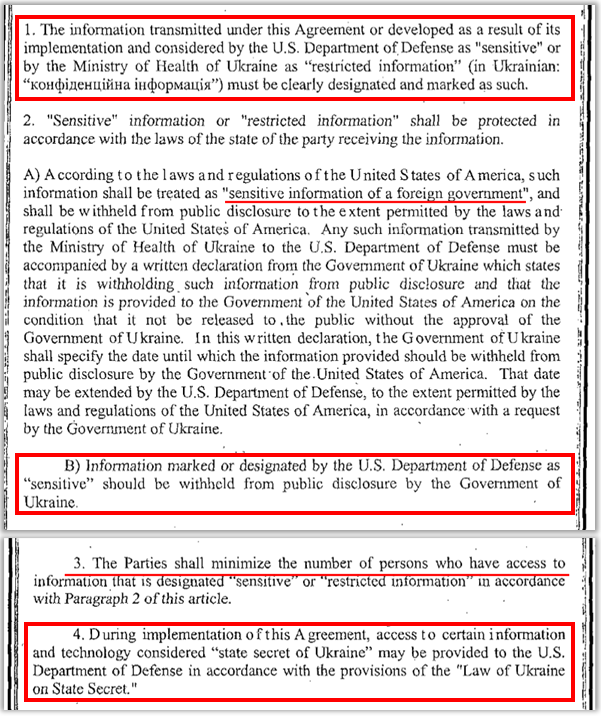
According
to the 2005 Agreement
between the US DoD and the Ministry of Health of Ukraine the
Ukrainian government is prohibited from public disclosure of
sensitive information about the US program. The
Pentagon has been operating 11 biolaboartories in Ukraine.
Porton
Down is just one of the
Pentagon-funded military laboratories in
25 countries across the world, where the US Army produces and tests
man-made viruses, bacteria and toxins in direct violation of the UN
convention. These US bio-laboratories are funded by the Defense
Threat Reduction Agency (DTRA) under a $
2.1 billion military program–
Cooperative Biological Engagement Program (CBEP), and are located in
former Soviet Union countries such as Georgia and Ukraine, the Middle
East, South East Asia and Africa.
The
Pentagon-funded military facilities are not under the direct control
of the host state as the US military and civilian personnel is
working under diplomatic cover. As the local governments and
communities are prohibited from public disclosure of sensitive
information about the foreign military program running on their own
territory – the full extent of the public risk will always remain
unknown. Consequently, without being under the direct control of
the host
state,
these Pentagon bio-laboratories put the health of the local
population at risk and must be closed.
Author
Dilyana Gaytandzhieva is a Bulgarian-based investigative journalist,
specializing in covering conflicts and terrorism in Middle East and
Asian conflicts, and international weapons trafficking operations.



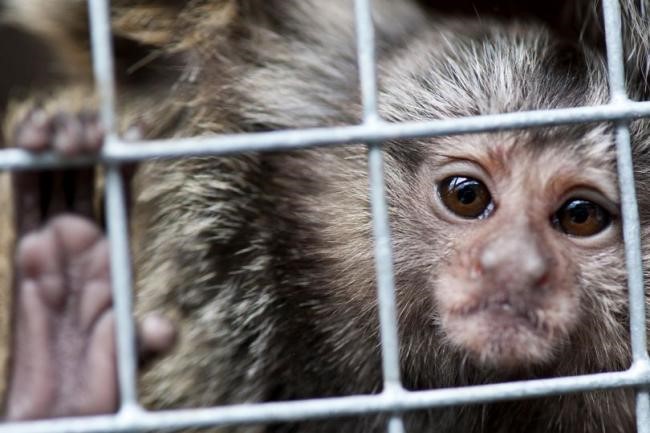
I admire all the fine research that went into the creation of this article but it represents a special form of journalism intended to create fear through sensationalism. The public has a right to be alerted to such hazards but not by use of these journalistic tactics.
ReplyDeleteI would have liked to have seen dates provided for some of the cited experiments. I expect that many go back many decades.
Readers should ask why the journalist tried to connect the recent poisoning of Sergei Skripal and his daughter Yulia with Porton Down. What evidence was there that connects the nerve agent used on them with this laboratory in the U.K.? Why did the journalist try to make a connection between the pet guinea pings, shown in the house of the poisoned ex-spy in Salisbury, with the use of guinea pigs as test animals at the Porton Down facility.
In the mind of a conspiracy oriented journalist the above links are important to expose even if there is no real evidence linking them. They know that readers, who think similarly, are not going to bother to critically look at such associations.
The journalist mentioned that a chemical gas was released in the London Underground but conveniently didn't mention that it wasn't a toxic chemical. Why would a journalist obscure that in their writing? Could that be construed as a form of deception of the public they are trying to reach?
If the journalist had wanted to present a more balanced story she might have included some of the safety features of the Porton Down facility but that aspect was a totally absent in this article.
Near the end the journalist paints a picture of herself as a victim. That is a process often used to deflect criticism of their works. Frequently it is referred to as "playing the victim card."
I admire much of Dilyana Gaytandzhieva's fine investigative work but some level of criticism is also due.
In a collapsing world one should expect a great deal of distractions away from the human caused 6th mass extinction event.
If my little critique got you to see some weakness that you hadn't noticed before you might ask why that was.
~ Vernon Brechin